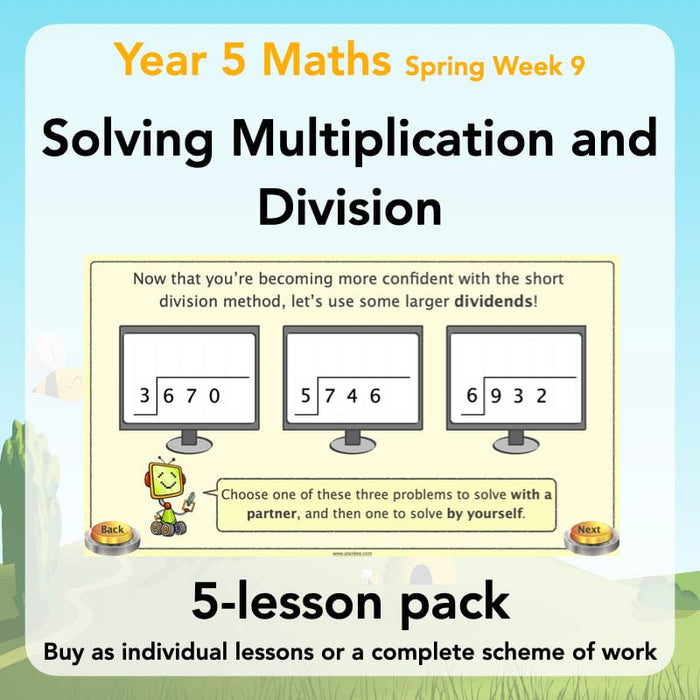

Increase your class’s confidence when using and applying their multiplication and division knowledge with this exciting scheme of work for Year 5. The first two lessons focus on short division, and developing children’s confidence when using this method. They then learn how to interpret remainders according to the context. The final two lessons encourage children to apply their multiplication and division skills through scaled drawings and simple rates problems.
What is short division? In this first lesson, children are introduced to this formal method. As a class, they work through several examples where a two-digit number is divided by a one-digit number, moving on to including examples where exchanging is needed and remainders are part of the final answer. In their independent activities, children practise this skill by solving given number sentences and matching up dividends, divisors and quotients to create correct number sentences. In the alternative activity, they compare the short division method with the chunking method.
Introducing the Short Division Method
What is short division? In this first lesson, children are introduced to this formal method. As a class, they work through several examples where a two-digit number is divided by a one-digit number, moving on to including examples where exchanging is needed and remainders are part of the final answer. In their independent activities, children practise this skill by solving given number sentences and matching up dividends, divisors and quotients to create correct number sentences. In the alternative activity, they compare the short division method with the chunking method.
What's included:
- Lesson plan
- Slides
- Activity ideas
- Differentiated worksheets
- Division Cards
- Chunking vs Short Division Game
- Thought Bubble Cards
Applying the Short Division Method
Children continue to develop their knowledge and understanding of the short method for division by using numbers with larger dividends. They learn what to do when a number in the dividend is smaller than the divisor, and understand how to solve number sentences that include a zero. In their independent activities, children are tasked to conduct a quality control check, and identify errors in given number sentences. In the FSD? activity, children find missing digits in given short division methods, where each digit corresponds to a letter which will spell out the punchline of a robot-themed joke.
What's included:
- Lesson plan
- Slides
- Activity ideas
- Differentiated worksheets
- Quality Control Card
- Robotic Jokes Sheet
Interpreting Remainders
What is a remainder? In this lesson, children focus on this part of the answer to division problems, and what this figure actually means. They learn that, when solving word problems, sometimes the remainder needs to be used in the answer, and sometimes it does not. As a class, they look at different word problems and discuss how to interpret the remainder in each one, using the abbreviation DURT (Drop, Use, Round or Turn the remainder into a fraction/decimal). In their independent activities, children sort and solve a variety of word problems based on interpretation of the remainder.
What's included:
- Lesson plan
- Slides
- Activity ideas
- Differentiated worksheets
- Card Set A/B/C
- Build-a-Bot Board game
- Question Cards
- Instructions Cards
- Bot Bits
- Bot Body Card
Scaled Drawings
Children apply their knowledge and understanding of multiplication and division in this lesson, in order to scale up and scale down given measurements of different objects. In their independent activities, children help some design engineers to increase and decrease the size of different robot parts. In the alternative activity, they are challenged to see how many 2D shapes they can measure, then scale up or down to fit on their worksheet.
What's included:
- Lesson plan
- Slides
- Activity ideas
- Differentiated worksheets
- Robot Cards
- 10mm Squared Paper
- Challenge Cards
- Challenge Sheet
Problems involving Rates
In this final lesson, children learn what a rate is, and how to find the unit rate when comparing two different quantities. As a class, they use their knowledge and skills of division and multiplication to answer various problems involving rates. Children continue to apply this skill in their independent activities. In the alternative activity, they compare supermarket offers by finding the unit price of different products, and then working out which is the cheapest shop overall.
What's included:
- Lesson plan
- Slides
- Activity ideas
- Differentiated worksheets
- Battle of the Bargains! Sheet

























































